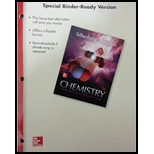
(a)
Interpretation:
For the hydrolysis of ATP, the equilibrium constant
Concept introduction:
Adenosine triphosphate ATP: The main job of ATP is to store energy and release it when cell is in need of energy.
Free energy change
Where,
(a)
Answer to Problem 20.99P
The hydrolysis of ATP is equilbrium constant value is
Explanation of Solution
The chemical equation for hydrolysis of ATP is,
Free energy equation is,
Consider the reaction (1) hydrolysis of ATP
Calculation for equilibrium constant
We know that equilibrium equation,
Rearrange the above equation,
The hydrolysis of ATP is equilbrium constant value is
(b)
Interpretation:
For the dehydration condensation to from glucose phosphate, the equilibrium constant
Concept introduction:
Free energy change: The free energy change of a reaction is given by the subtraction of free energy changes of reactants from free energy changes of reactants.
Free energy change
Where,
(b)
Answer to Problem 20.99P
The ATPs, dehydration equilbrium is
Explanation of Solution
The chemical equation for dehydration of ATP is,
Free energy equation is,
Consider the reaction (2) dehydration of ATP
Calculation for equilibrium constant
We know that equilibrium equation,
Rearrange the above equation,
Hence, the ATPs, dehydration equilbrium is
(c)
Interpretation:
For the coupled reaction between ATP and glucose
Concept introduction:
Free energy change: The free energy change of a reaction is given by the subtraction of free energy changes of reactants from free energy changes of reactants.
Free energy change
Where,
(c)
Answer to Problem 20.99P
Given coupled reaction equilbrium value is
Explanation of Solution
The chemical equation for dehydration of ATP is,
Free energy equation is,
Consider the coupled (3) reaction between ATP and glucose is,
The equilibrium equation,
Rearrange the above equation to calculate
Hence, the coupled reaction equilbrium value is
(d)
Interpretation:
Identify the change in
Concept introduction:
Free energy change: The free energy change of a reaction is given by the subtraction of free energy changes of reactants from free energy changes of reactants.
Free energy change
Where,
(d)
Answer to Problem 20.99P
Given each reactions equilibrium changes has
Explanation of Solution
The chemical equation of ATP is,
The temperature changes from
The calculations at the new temperature
The equilibrium equation,
Case-1
Case-2
Case-3
Hence, the each cases equilibrium changes has
Want to see more full solutions like this?
Chapter 20 Solutions
Chemistry: The Molecular Nature of Matter and Change (Looseleaf)
- Draw the product of this reaction please. Ignore inorganic byproductsarrow_forwardOne of the pi molecular orbitals of 1,3-butadiene (CH2=CHCH=CH2) is shown below. Please identify the number of nodal planes perpendicular to the bonding axisarrow_forwardDraw the monomers required to synthesize this condensation polymer please.arrow_forward
- Provide the correct systematic name for the compound shown here. Please take into account the keyboard options belowarrow_forwardcurved arrows are used to illustrate the flow of electrons. using the provided starting and product structures, draw the curved electron-pushing arrows for the following reaction or mechanistic step(s)arrow_forwardIdentify the 'cartoon' drawing of the acceptor orbital in the first mechanistic step of an electrophilic addition reaction of butadiene with HBr. Pleasearrow_forward
- H- H H H H H H Identify and select all structures below that represent a constitutional isomer(s) of the compound shown above. H- H H H A. H H H H-C CI H H D. H H H H H H C C -H H C C H H H H B. H CI H H- C C H H H H E. H CI H C.arrow_forwardWhy doesn't this carry on to form a ring by deprotonating the alpha carbon and the negatively-charged carbon attacking the C=O?arrow_forward6. A solution (0.0004 M) of Fe(S2CNEt2)3 (see the structural drawing below) in chloroform has absorption bands at: 350 nm (absorbance A = 2.34); 514 nm(absorbance A = 0.0532); Calculate the molar absorptivity values for these bands. Comment on their possible nature (charge transfer transitions or d-d S N- transitions?). (4 points)arrow_forward
- What is the mechanism for this?arrow_forwardFor questions 1-4, consider the following complexes: [Co(CN)6], [COC14]², [Cr(H2O)6]²+ 4. Room temperature (20°C) measurement of molar magnetic susceptibility (Xm) for Fe(NH4)2(SO4)2×6H2O is 1.1888 x 102 cgs (Gaussian units). Calculate effective magnetic moment and provide a number of unpaired electrons for the iron ion. Use this number to rationalize the coordination geometry around iron center. (4 points)arrow_forward7. Describe the expected 31P and 19F (where applicable) NMR spectral patterns for the following compounds (indicate number of signals and their splitting patterns). a) tetraphenyldiphosphine Ph Ph P-P Ph Ph Ph Ph ' b) tetraphenyldiphosphine monoxide P-P-Ph Ph (2 points) (2 points c) tetrafluorophosphonium hexafluorophosphate [PF4]*[PF6]¯ (4 points)arrow_forward
 ChemistryChemistryISBN:9781305957404Author:Steven S. Zumdahl, Susan A. Zumdahl, Donald J. DeCostePublisher:Cengage Learning
ChemistryChemistryISBN:9781305957404Author:Steven S. Zumdahl, Susan A. Zumdahl, Donald J. DeCostePublisher:Cengage Learning ChemistryChemistryISBN:9781259911156Author:Raymond Chang Dr., Jason Overby ProfessorPublisher:McGraw-Hill Education
ChemistryChemistryISBN:9781259911156Author:Raymond Chang Dr., Jason Overby ProfessorPublisher:McGraw-Hill Education Principles of Instrumental AnalysisChemistryISBN:9781305577213Author:Douglas A. Skoog, F. James Holler, Stanley R. CrouchPublisher:Cengage Learning
Principles of Instrumental AnalysisChemistryISBN:9781305577213Author:Douglas A. Skoog, F. James Holler, Stanley R. CrouchPublisher:Cengage Learning Organic ChemistryChemistryISBN:9780078021558Author:Janice Gorzynski Smith Dr.Publisher:McGraw-Hill Education
Organic ChemistryChemistryISBN:9780078021558Author:Janice Gorzynski Smith Dr.Publisher:McGraw-Hill Education Chemistry: Principles and ReactionsChemistryISBN:9781305079373Author:William L. Masterton, Cecile N. HurleyPublisher:Cengage Learning
Chemistry: Principles and ReactionsChemistryISBN:9781305079373Author:William L. Masterton, Cecile N. HurleyPublisher:Cengage Learning Elementary Principles of Chemical Processes, Bind...ChemistryISBN:9781118431221Author:Richard M. Felder, Ronald W. Rousseau, Lisa G. BullardPublisher:WILEY
Elementary Principles of Chemical Processes, Bind...ChemistryISBN:9781118431221Author:Richard M. Felder, Ronald W. Rousseau, Lisa G. BullardPublisher:WILEY





